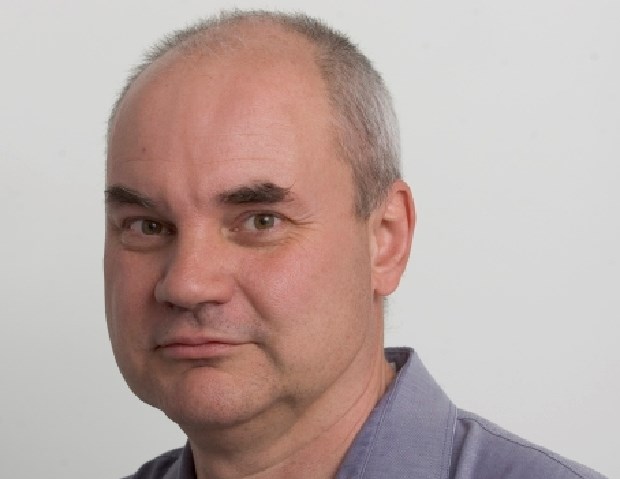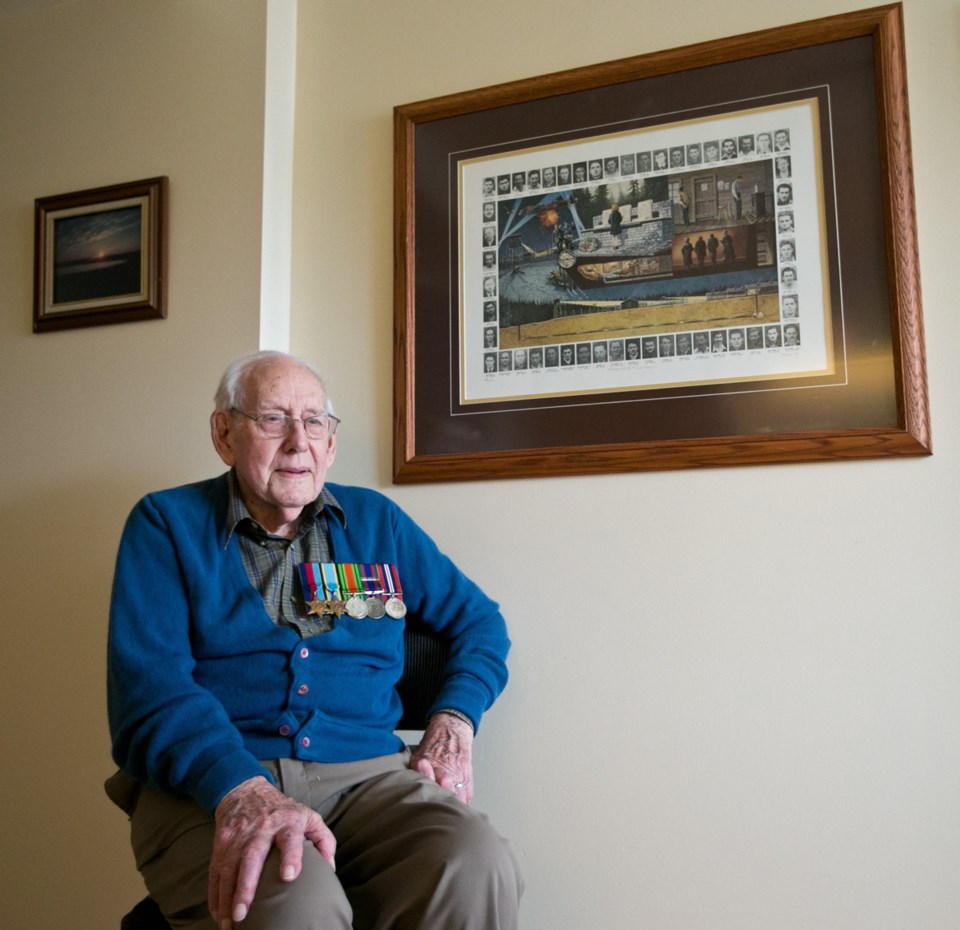 In the evenings, Mac Colquhoun would stroll the grounds of the prisoner-of-war camp with bags of dirt hidden inside his clothing.
In the evenings, Mac Colquhoun would stroll the grounds of the prisoner-of-war camp with bags of dirt hidden inside his clothing.
Pull a string — sitting in his room in Saanich’s Lodge at Broadmead, the 98-year-old reaches in his pockets to show how it was done — and the sandy soil would fall out his pant legs.
That’s how the Allied prisoners got rid of the dirt from their escape tunnel.
Maybe you saw that scene depicted in classic Second World War movies such as The Great Escape and The Wooden Horse, but Colquhoun actually lived it.
Never mind Steve McQueen and Hollywood, the real McCoy resides right here in Victoria.
Mac Colquhoun was a Saskatchewan farm boy who signed up with the Royal Canadian Air Force in 1940.
On the night of Jan. 27, 1943, his Halifax bomber was crippled by heavy flak west of Dusseldorf, Germany. Flight Lt. Colquhoun, the navigator, parachuted into a farmer’s field. Another crew member landed safely, too, though a third died in the attempt. The rest of the crew of seven and the plane itself were never accounted for.
Colquhoun ended up in a Luftwaffe-run PoW camp near the town of Sagan, now part of Poland. It’s where both the Wooden Horse and the Great Escape took place.
He was directly involved in the former, a clever escapade in which prisoners used the plywood from Red Cross crates to build a gymnastics horse, which, every day, they would carry to the same spot in the prison yard — right over the hidden entrance to a tunnel. Inside the hollow exercise apparatus were hidden one or two prisoners who would do the digging, carefully covering the tunnel entrance with wood and topsoil before being carried back inside with that day’s excavated dirt.
“My department was looking after hiding the dirt that came out,” Colquhoun says. “I hauled a lot of dirt.”
It was tricky, though. The yellow sand from the tunnel stood out from the surface soil. “As soon as that showed up, they knew we were digging.”
So some of the sand was buried under the camp’s many vegetable gardens. Some was stored in a roof. Some was poured down holes cut in a theatre stage.
Much was dispersed through the down-the-leg method described earlier. The bags that held the sand were about four feet long, sewn from old pant legs and hooked to the wearer’s suspenders. As Colquhoun and others dribbled the sand out, other prisoners would scuff it into the dirt.
“We made sure everybody in the camp was out walking when we had this sand to spread.”
In October 1943, three prisoners escaped.
“The people who were selected spoke German, knew the country and had a decent chance of getting home.” Indeed, all three made it to Britain safely.
The same couldn’t be said of the Great Escape, hatched just across the wire in a neighbouring compound within the Sagan camp. “We knew what was going on, but it was across the fence from us.”
Of the 76 who escaped, 73 were recaptured, and 50 of those — including six Canadians — were executed. Colquhoun heard that Adolf Hitler himself decided which of the prisoners would be killed.
“They were all shot. All they did was escape. There’s no law against that, but that was Hitler’s cure.”
In retrospect, then, Colquhoun is glad that an air raid disrupted the original plan, which was to have more than 200 men escape. “That stopped everything, and I’m glad it did. There would have been a slaughter if 250 got out.”
As for the 1963 Great Escape movie, it was largely accurate, though there were no Americans among the escapees (by contrast, the key real-life role played by Canadians is documented in Ted Barris’s book The Great Escape: A Canadian Story) and no, nobody jumped the barbed wire on a motorcycle. “Steve McQueen had to have a role that made him do something that benefited his career in the movies,” Colquhoun says.
On Jan. 27, 1945, exactly two years after Colquhoun was shot down, and with Russian soldiers streaming past, the Sagan prisoners were ordered west to a German camp near Denmark.
It was a brutal journey — 30 below, and the PoWs had no winter wear. “It was desperately cold, nowhere to go at night, just about the worst you can think of.” The other surviving member of Colquhoun’s bomber crew was among those who froze to death. “I thought I was lucky that I had walked to school on the Prairies and knew what cold was.”
In May, as Germany descended into end-of-the-war chaos, the prison guards disappeared. Rather than wait for liberators to arrive, Colquhoun and four others took matters into their own hands, commandeering a car that they drove 200 kilometres to an airport that they knew was being used by the Allies.
What happened next was recorded in a video documentary titled Mac: “We don’t have money to buy tickets, but we have a car of questionable ownership,” they told the guard at the airport gate. “There’s the keys.”
The guard said he would attempt to get the car back to its owners — eventually — and the PoWs were placed on the first plane to England. They made it to London just in time to get in on the wild VE-Day celebrations in Piccadilly Circus.
By June 1945, Colquhoun was back in Canada and on the path to a peaceful life as a family man, a 25-year career in accounting and an even longer retirement in Penticton. He moved to Victoria three years ago.
On his wall in the Lodge at Broadmead hangs a picture depicting life at Sagan, the montage bordered by photos of the 50 men executed after the Great Escape.
Colquhoun’s eyesight is mostly gone now, but those photos, those memories, remain sharp.
For the rest of us, it was the stuff of movies, but for Mac Colquhoun it was real life.
__________
Mac Colquhoun lives at the Lodge at Broadmead, where half of the 229 residents are veterans.
The Saanich facility is nearing the end of a campaign to equip all of its rooms with bed lifts. Until Nov. 12, there’s an initiative where shoppers at Victoria-area Thrifty Foods stores can make a $2 contribution at the checkout.
Victoria philanthropist Rudi Hoenson has offered $200,000 to match any contributions from the public, effectively doubling the value of any donation. For 92-year-old Hoenson, who as a prisoner of war survived the 1945 atomic bomb in Nagasaki, it’s a way of honouring his fellow veterans on the 70th anniversary of the end of the war.



